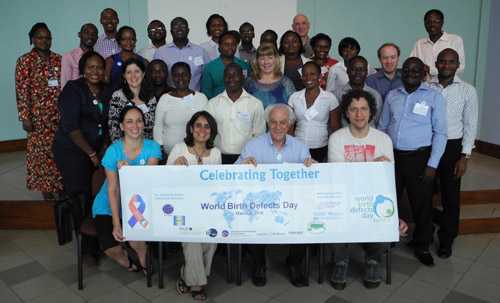Birth Defects COUNT Partner Newsletter

Welcome

A Message from the NCBDDD Director
Dear Colleagues:
We hope you are all doing well. As we reflect upon all of the work that has been done this year, we are excited to see how Birth Defects COUNT and its partners individually and collectively continue to make great strides toward global birth defects prevention and care.
In this issue, we highlight the many recent Birth Defects COUNT scientific and programmatic successes. It has been an exciting year so far! In collaboration with partners, we have conducted a first-ever intermediate birth defects surveillance workshop in Tanzania for six African countries, co-facilitated a Regional Program Managers Meeting on Prevention and Surveillance of Birth Defects in India, and provided scientific review of evidence to WHO on the development of an optimal blood folate guideline for the prevention of neural tube defects.
We realize that the hard work and dedication of our many partners is critical to promoting the health and well-being of babies around the world. We look forward to advancing our work with current partners and growing our global network of collaborators.
Coleen A. Boyle, PhD, MS hyg
Director, National Center on Birth Defects and Developmental Disabilities
Centers for Disease Control and Prevention
Program Highlight
WHO releases guideline to help prevent neural tube defects
Globally, about 300,000 babies are born every year with a neural tube defect, serious birth defects of the brain and spine; however, the true count is not currently known due to a lack of birth defects data in many countries. A new guideline, released by the World Health Organization (WHO), provides countries with a tool to assess population-level risk for neural tube defects. The guideline can help countries determine the need for, and effectiveness of, neural tube defects prevention programs, including folic acid fortification and supplementation. The WHO guideline, if adopted, can help countries identify the risk of neural tube defects while their birth defects surveillance systems are under development or to complement data from existing systems. CDC has developed a webpage to help public health professionals, policymakers, and scientific staff around the world to better understand the guideline’s implications for public health practice. We welcome you to visit WHO’s website to read the guideline in its entirety.
Partner Spotlight
Introducing the Food Fortification Initiative: Enhancing grains for healthier lives
The Food Fortification Initiative (FFI) is a multi-sector, international partnership working to prevent neural tube defects and nutritional anemia by advocating for fortification of industrially milled wheat flour, maize flour, and rice.
FFI’s role is to support national leaders working towards grain fortification. The support provided through multi-sector collaboration includes
- Advocacy resources on the benefits of fortification;
- Technical assistance for planning, implementing, and monitoring sustainable fortification programs; and
- Tracking progress at the country and global levels.
Fortifying wheat flour with folic acid prevents thousands of neural tube defects globally each year. Yet FFI estimates that only 30% of the world’s industrially milled wheat flour is fortified with at least folic acid and/or iron. A higher percentage (48%) of industrially milled maize flour is fortified, but very little maize flour is industrially milled. Recently, FFI added rice to its portfolio of fortification vehicles. Rice represents a previously untapped opportunity as only 1% of industrially milled rice is fortified.
A policy planning forum held in Mauritius in 2002 helped launch FFI. This was the first public effort to organize wheat flour fortification at a global level. At the time, widespread wheat flour fortification in the Middle East and the Americas had been established through regional strategies, but there was no international body focused on advocating for fortification to become a standard milling practice globally. Partners involved in this early effort included Emory University, the Micronutrient Initiative, U.S. Centers for Disease Control and Prevention, and the Association of Operative Millers (now known as the International Association of Operative Millers).
By 2003, this global partnership was called the Flour Fortification Initiative, initially focusing on the fortification of wheat flour. In 2014, the partnership’s name was changed to the Food Fortification Initiative to reflect the addition of industrially milled maize flour and rice to the scope of work.
In 2002, 44 countries had legislation to fortify wheat flour. Now 83 countries have legislation to mandate fortification of wheat flour, maize flour, and/or rice. FFI looks forward to further advancing global grain fortification efforts in collaboration with Birth Defects COUNT.
FFI has a small Global Secretariat at Emory University in Atlanta, Georgia, USA. Individual staff members are based in Canada, India, The Netherlands, Thailand, Uganda, and Viet Nam.
Read more: www.ffinetwork.org.
News & Events

CDC and Partners Advance Training Efforts to Build Capacity for Birth Defects Surveillance in Africa
As infant illness and deaths from infectious diseases have declined in many African countries, the burden from non-infectious diseases has become more evident. According to the World Health Organization, birth defects rank among the top 10 leading causes of infant deaths in Africa. As part of ongoing efforts in Africa, Birth Defects COUNT works to raise awareness among country-level health officials about the need for data on the burden of birth defects. Better data require developing or improving birth defects surveillance systems. These data can then be used for prevention efforts. Currently, there are no birth defects surveillance programs in place in Africa.
As countries in Africa have moved to address birth defects, Birth Defects COUNT has provided support for the development and implementation of birth defects surveillance programs. On March 1, 2015 in Arusha, Tanzania, a partner group comprising the World Health Organization, the International Federation for Spina Bifida and Hydrocephalus, the International Clearinghouse for Birth Defects Surveillance and Research, the March of Dimes, and the U.S. Centers for Disease Control and Prevention convened a birth defects surveillance workshop. Participants included representatives from six African countries: Tanzania, Kenya, Rwanda, Malawi, Uganda, and Nigeria. The workshop was tailored to the needs of the countries, with the goal of helping them move from development of surveillance plans to actual implementation within the year.
The participating countries had already developed protocols on how they would develop and maintain birth defects surveillance systems. The goal of the workshop was to provide participants with feedback on their country protocols, to help clarify questions they had about surveillance, and to teach participants how to describe and code birth defects so that accurate data may be collected. In advance of the workshop, the participants started training in December 2014 with a 10-week online course on different aspects of birth defects surveillance. Topics included an overview of birth defects, basic concepts of epidemiology, and several presentations on specific major structural birth defects. This rigorous online course was followed up with the March in-person workshop that covered the main elements of implementing and evaluating a birth defects surveillance system. Presentations and exercises at the workshop covered quality control, classification and coding, data analysis and interpretation, general principles of birth defects prevention (such as folic acid fortification), and preconception care in Africa. Breakout sessions, which allowed participants to discuss and refine their country-specific protocols, were a key part of the workshop. The workshop also included a visit to a busy birth defects clinic where participants had the opportunity to hear from mothers of affected children about the everyday challenges they face in caring for a child with special needs in a low resource setting. This visit highlighted the need for surveillance, prevention, and care, and referral programs for children with birth defects in Africa.
The participants left the workshop with a clear vision of next steps to implement their surveillance efforts, and with a refined skillset to better support their surveillance and prevention activities. Most importantly, participants left with a new network of like-minded public health professionals committed to birth defects prevention in Africa.
During the workshop, participants had the opportunity to celebrate together the first World Birth Defects Day, which gave participants the opportunity to see first-hand the potential impact of their work in global birth defects surveillance and prevention.
Regional Programme Managers Meeting on Prevention and Surveillance of Birth Defects: New Delhi, India
Representatives from the U.S. Centers for Disease Control and Prevention (CDC) attended the Regional Programme Managers Meeting on Prevention and Surveillance of Birth Defects in New Delhi, India in April 2015. The purpose of the meeting was to review the progress of birth defects surveillance and prevention efforts among member states in the World Health Organization’s South-East Asia region, as well as to provide guidance for next steps as countries implement their national birth defects prevention and communications plans.
Currently, nine countries (Bangladesh, Bhutan, India, Indonesia, Maldives, Myanmar, Nepal, Sri Lanka, and Thailand) in South-East Asia have national plans for or are conducting birth defects surveillance activities. Eight of these countries (Bangladesh, Bhutan, India, Indonesia, Myanmar, Nepal, Sri Lanka, and Thailand) have made progress in developing their birth defects surveillance systems and are reporting data. The regional database currently has 130,000 reported births with more than 1,000 birth defects cases.
These activities mark significant progress in the region considering that three years ago only very limited birth defects surveillance data were being collected in these countries. In the coming years, CDC will continue to provide technical assistance to help improve the capacity for birth defects surveillance and prevention in these countries.
Key Resources
Blood Folate Concentrations and Risk of Neural Tube Defect-Affected Pregnancies: Where Does the United States Stand?
Birth Defects Research Part A has published a study that looked at the amount of folate in the blood (“blood folate concentrations”) among women in the United States in relation to their risk of having a baby affected by a neural tube defect. In this study, CDC researchers found that more than 3 out of 4 (77.2%) women in the United States had blood folate concentrations at levels that would optimally prevent pregnancies affected by neural tube defects. These findings are useful for identifying population subgroups at greater risk for pregnancies affected by neural tube defects and targeting the ways to better prevent neural tube defects in those groups. Read more
Assessing the Association between Natural Food Folate Intake and Blood Folate Concentrations
The journal Nutrients has published a study that assessed the relationship between the amount of natural food folate consumed by women and their blood folate concentrations. In this study, CDC researchers conducted a systematic review and meta-analysis and found that
- Consuming natural food folate affects blood folate concentrations, and
- Adequate food folate consumption by women could help them achieve red blood cell folate concentrations that reduce their risk of having a pregnancy affected by a neural tube defect.
However, it is difficult for a woman to eat enough natural food folate to prevent neural tube defects. These findings will be useful for public health professionals and policymakers interested in preventing neural tube defects through a variety of interventions including folic acid fortification, supplementation, as well as through diet. Read more
- Page last reviewed: April 26, 2017
- Page last updated: September 9, 2015
- Content source:


 ShareCompartir
ShareCompartir